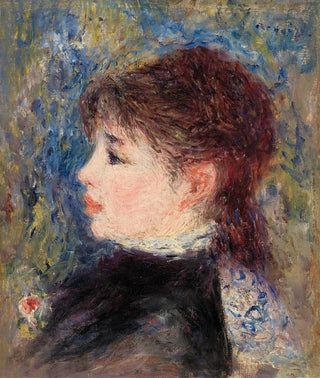Art print | Young Woman with Rose Jeune fille à la rose - Pierre-Auguste Renoir


View from behind

Frame (optional)
In the fascinating world of art, some works manage to capture not only the beauty of a moment but also the very essence of human emotion. "Young Woman with Rose," or "Jeune fille à la rose," by Pierre-Auguste Renoir, is one of those creations that transcends time. This painting, imbued with softness and light, evokes a rare delicacy, allowing the viewer to immerse themselves in a universe where beauty and sensitivity meet. The scene depicts a young woman, with a mysterious smile on her lips, holding a rose, a symbol of love and ephemeral beauty. Through this artwork, Renoir invites us to appreciate feminine grace while offering a suspended moment, a true ode to youth.
Style and uniqueness of the work
Renoir's style is distinguished by his masterful use of color and light. In "Young Woman with Rose," pastel tones intertwine harmoniously, creating a soft and dreamy atmosphere. The artist's Impressionist technique is evident in the fluid, dynamic brushstrokes that seem to capture the movement of the air and the ambient luminosity. The composition, centered on the radiant face of the young woman, immediately draws the eye. Her delicate features and serene expression are highlighted by the subtle contrast of shadows and lights, demonstrating Renoir's exceptional talent for rendering life and emotion on the canvas. The rose she holds, vibrant in color, almost becomes an extension of her own beauty, thus strengthening the link between nature and humanity.
The artist and his influence
Pierre-Auguste Renoir, an emblematic figure of the Impressionist movement, left his mark on his era with his unique vision of beauty. Born in 1841, he began his career painting scenes of everyday life before turning to portraits and landscapes. His approach to painting is characterized by a celebration of life, a quest for light, and an admiration for feminine beauty. Renoir influenced many artists, both through his style and his philosophy of art. His ability to capture the fleeting moment

Matte finish

View from behind

Frame (optional)
In the fascinating world of art, some works manage to capture not only the beauty of a moment but also the very essence of human emotion. "Young Woman with Rose," or "Jeune fille à la rose," by Pierre-Auguste Renoir, is one of those creations that transcends time. This painting, imbued with softness and light, evokes a rare delicacy, allowing the viewer to immerse themselves in a universe where beauty and sensitivity meet. The scene depicts a young woman, with a mysterious smile on her lips, holding a rose, a symbol of love and ephemeral beauty. Through this artwork, Renoir invites us to appreciate feminine grace while offering a suspended moment, a true ode to youth.
Style and uniqueness of the work
Renoir's style is distinguished by his masterful use of color and light. In "Young Woman with Rose," pastel tones intertwine harmoniously, creating a soft and dreamy atmosphere. The artist's Impressionist technique is evident in the fluid, dynamic brushstrokes that seem to capture the movement of the air and the ambient luminosity. The composition, centered on the radiant face of the young woman, immediately draws the eye. Her delicate features and serene expression are highlighted by the subtle contrast of shadows and lights, demonstrating Renoir's exceptional talent for rendering life and emotion on the canvas. The rose she holds, vibrant in color, almost becomes an extension of her own beauty, thus strengthening the link between nature and humanity.
The artist and his influence
Pierre-Auguste Renoir, an emblematic figure of the Impressionist movement, left his mark on his era with his unique vision of beauty. Born in 1841, he began his career painting scenes of everyday life before turning to portraits and landscapes. His approach to painting is characterized by a celebration of life, a quest for light, and an admiration for feminine beauty. Renoir influenced many artists, both through his style and his philosophy of art. His ability to capture the fleeting moment






